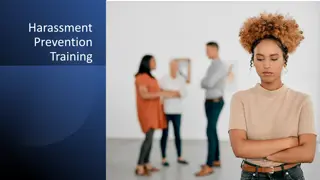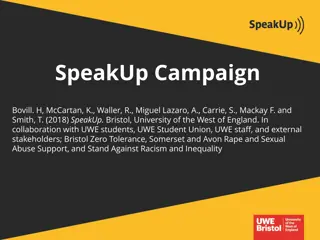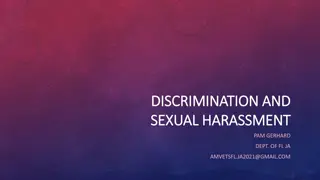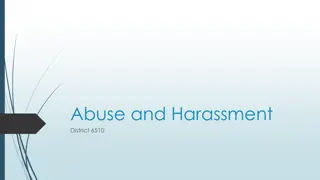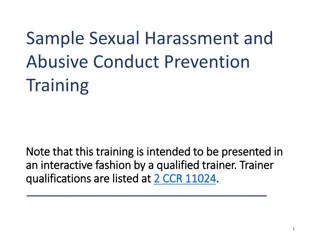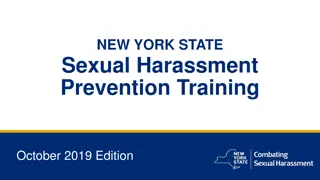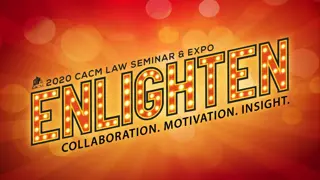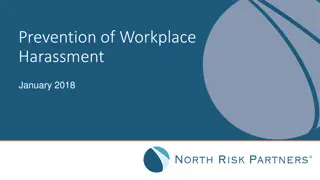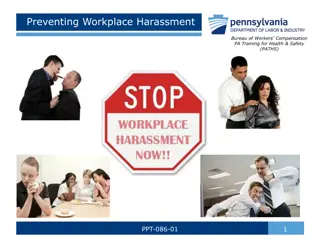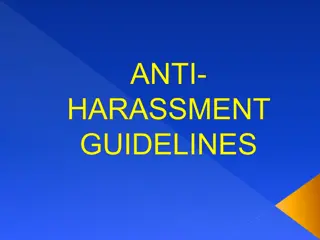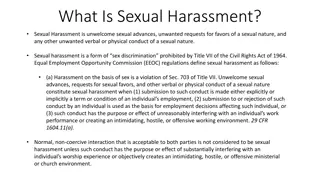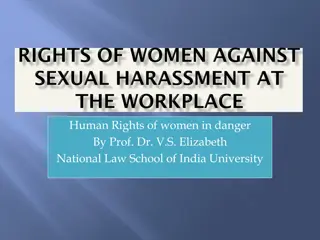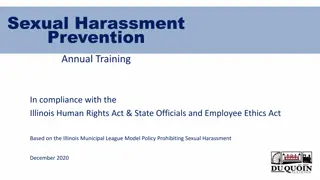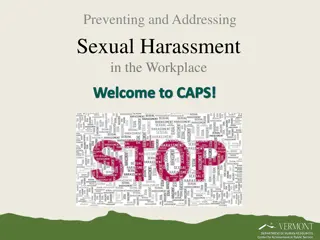SEXUAL HARASSMENT
Explore the legal landscape of sexual harassment in schools under Title IX and Title VII, covering employee and student rights, definitions, claims, and categories. Learn why it's crucial to address and prevent sexual harassment in educational settings to maintain a safe and respectful environment.
Download Presentation

Please find below an Image/Link to download the presentation.
The content on the website is provided AS IS for your information and personal use only. It may not be sold, licensed, or shared on other websites without obtaining consent from the author.If you encounter any issues during the download, it is possible that the publisher has removed the file from their server.
You are allowed to download the files provided on this website for personal or commercial use, subject to the condition that they are used lawfully. All files are the property of their respective owners.
The content on the website is provided AS IS for your information and personal use only. It may not be sold, licensed, or shared on other websites without obtaining consent from the author.
E N D
Presentation Transcript
SEXUAL HARASSMENT Title IX of the Education Amendments of 1972 Title VII of the Civil Rights Act of 1964 PATRICIA A. ADAMS CHIEF LEGAL COUNSEL
WHY DO WE NEED TO TALK ABOUT THIS Every employee and every student has a legally protected right to work and learn in an environment free from sexually harassing behavior by supervisors, co-workers or any other member of the school community. You need to know what it looks like. You need to know that it is prohibited by state and federal law and Board policy and that you can, and will, be fired if it is determined that you sexually harassed a co-worker or a student. You need to know what to do if you feel that you are a victim of sexual harassment. You need to know what to do if you observe inappropriate behavior particularly if it involves a student. You need to help me keep the District from being sued!!
OVERVIEW Sexual harassment in schools presents two legal topics: 1. The sexual harassment of employees 2. The sexual harassment of students
PART 1 SEXUAL HARASSMENT OF EMPLOYEES
EMPLOYEE CLAIMS Title VII of the Civil Rights Act of 1964 establishes the basic law regarding sexual harassment in the workplace. Employees may also bring sexual harassment claims under state law, the 14thAmendment, school board policies, and even negligence theories.
Sexual Harassment as Defined Under Title VII Unwelcome sexual advances, requests for sexual favors, and other verbal or physical conduct of a sexual nature when: (1) Submission to such conduct is made a term or condition of employment; Submission or rejection of such conduct is used as a basis for employment decisions; or Such conduct unreasonably interferes with performance or creates a hostile work environment. (2) (3) 29 C.F.R 1604.11
Categories of Sexual Harassment Quid pro quo this for that when a supervisor makes promises or threats in exchange for sex or submission to sexual behavior. Hostile environment sexually based conduct so severe and pervasive that it alters the conditions of employment and creates an abusive environment.
Examples of prohibited conduct 1. 2. 3. Graphic verbal comments about an individual's body or appearance. Sexual jokes, notes, stories, drawings, pictures, or gestures. Sexual slurs, leering, threats, abusive words, derogatory comments, or sexually degrading descriptions. Unwelcome sexual flirtations or propositions for sexual activity or unwelcome demands for sexual favors, including, but not limited to, repeated unwelcome requests for dates. Spreading sexual rumors. Touching an individual's body or clothes (including one's own) in a sexual way, including, but not limited to, grabbing, brushing against, patting, pinching, bumping, rubbing, kissing, and fondling. Cornering or blocking normal movements. Displaying sexually suggestive drawings, pictures, written materials, and objects in the educational environment. 4. 5. 6. 7. 8.
EMPLOYER LIABILITY An employer will be held strictly liable if it is determined that a supervisor made a tangible employment decision based on an employee s refusal of sex. An employer may still be held liable for a supervisor s sexually harassing behavior, even if the employee did not suffer a tangible adverse action, unless the employer can show that: Employer took reasonable steps to prevent and promptly correct the supervisor s sexually harassing behavior Employee failed to use preventive or corrective measures to avoid harm.
EMPLOYER LIABILITY What if an employee claims that a co-worker or vendor created a hostile work environment? The employer will be held liable if a supervisor knew, or should have known, about the harassment and failed to take timely and effective corrective action reasonably calculated to end the harassment.
Nontraditional Protections Same sex harassment actionable. Oncale v. Sundowner Offshore Srvcs., 523 U.S. 75 (1998) Gender stereotyping actionable. Price Waterhouse v. Hopkins, 490 U.S. 228 (1989) Sexual orientation and transgender status actionable. Bostock v. Clayton County Georgia, 140 S. Ct. 1731 (2020)
Board Policy GAEAA Title VII Employee Sexual Harassment You will find it on the District website under Board Policies Contains detailed procedures for reporting and investigating complaints of sexual harassment Go to building level supervisor or H.R. Never have to report to the alleged harasser Retaliation prohibited Encouraged to report inappropriate behavior that you observe in the workplace to your supervisor or higher up, if necessary
PART 2 SEXUAL HARASSMENT OF STUDENTS
MANDATORY REPORTERS La. Child. Code Ann. art. 609(A)(1) provides that any mandatory reporter who has reason to believe that a child's physical or mental health or welfare is endangered as a result of abuse or neglect shall report in accordance with La. Child. Code Ann. art. 610. A violation of the duties imposed upon a mandatory reporter subjects the offender to criminal prosecution authorized by La. Rev. Stat. Ann. 14:403(A)(1). La. Child. Code Ann. art. 609(A)(2). If you are aware of conduct by an adult that may constitute child sex abuse , you are required to report to DCFS or local law enforcement, or to make sure that it gets reported.
Student Sexual Harassment Claims Title IX establishes the basic law regarding sexual harassment claims by students. Students may also bring sexual harassment claims under school district policies, state anti-bullying or anti-harassment statutes, negligence theories.
Types of Student Sexual Harassment Quid pro quo an educational decision or benefit is based on a student s submission to unwelcome sexual conduct. Hostile environment acts of severe, pervasive, and objectively offensive conduct or harassment.
Elements of a Title IX Claim Employee-to-Student An appropriate school official must: Have actual knowledge of discrimination Fail to respond adequately Response must amount to deliberate indifference Gebser v. Lago Vista Independent School District, 524 U.S. 274 (1998)
Elements of a Title IX Claim Peer-to-Peer Sexual Harassment An appropriate person must have had actual knowledge of the alleged harassment. The sexual harassment must be severe, pervasive, and objectively offensive. The school district responded with deliberate indifference; and The student/victim must have been denied an educational opportunity or benefit. Davis v. Monroe Cty Bd of Educ, 526 U.S. 629 (1999)
Appropriate Person A teacher is an appropriate person for purposes of establishing liability under Title IX. Therefore, it is very important that you report any inappropriate sexual conduct that you observe - or otherwise learn of involving students.
Board Policy JAAA Title IX Sexual Harassment Dr. Gretchen Williams, Executor Director of Compliance, is our Title IX Coordinator. Board policy sets forth detailed directions for reporting allegations of sexual harassment involving students. Dr. Williams will initiate an investigation and supportive measures for the student(s), as needed. Title IX prohibits retaliation against an employee or student who reports sexual harassment.
Sexual Orientation Transgender Status DOE/OCR guidance says that Title IX covers sexual orientation and transgender status. Several circuit courts have held that discrimination against LGBTQI+ students is a violation of Title IX The Supreme Court has not ruled on this issue with respect to Title IX Bostock v. Clayton courts often apply Title VII standards to Title IX cases
THANK YOU! ANY QUESTIONS? Patricia A. Adams Chief Legal Counsel padams.legal@jpschools.org
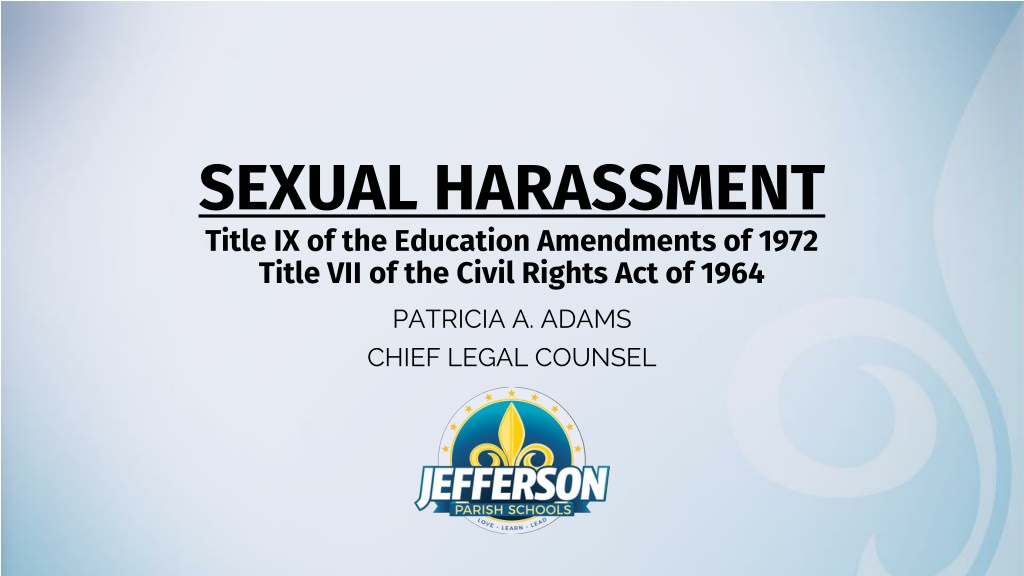
 undefined
undefined







